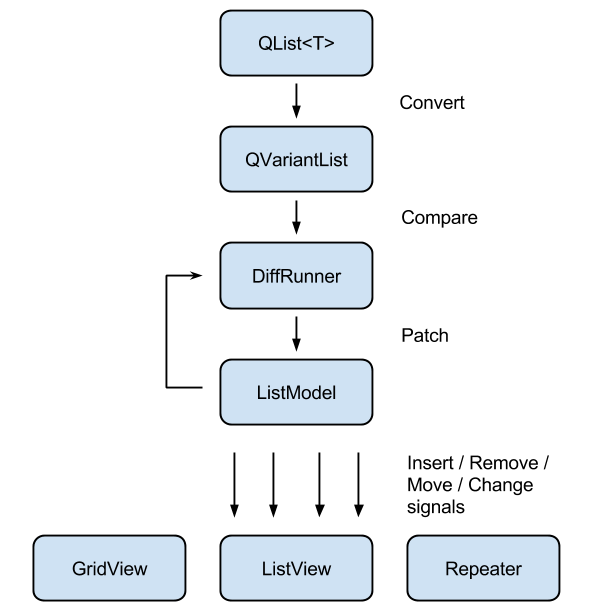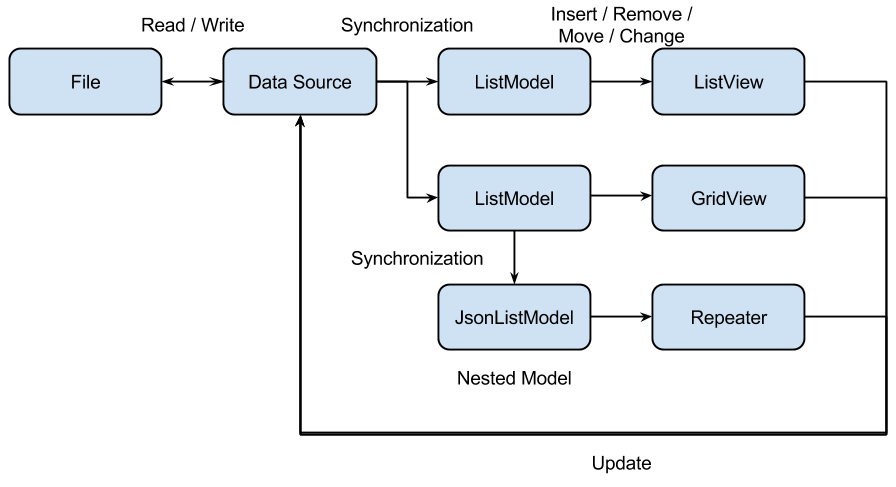QSyncable provides a QML friendly list model (based on QAbstractItemModel) as a wrapper of any data structure from C++ / Javascript. Instead, to access data from the original source per query, it duplicates a copy of data locally, and keep updated by an average O(n) synchronization algorithm. Every update is carried by passing a full copy of data snapshot. It will find out the diff and transform into a list of change operations like insertion, removal and move. It will guarantee the behaviour is identical to the original QML ListModel. Therefore, UI components could react to the changes correctly.
An immediate benefit of using QSycnable is the simplification of the data pipeline. If you need your UI to respond to changes like insertion/removal correctly, you must update the ListModel by the corresponding method explicitly. QSyncable combines all kinds of update methods into a single way. Such that user doesn’t need to care about their differences and setup data binding by just a single connection.
Moreover, QSyncable could also be used as a solution for the nested list model.
Reference:
DiffRunner (QSDiffRunner) compares two QVariantList to produce a patch for transforming one of a list to another list with minimum no. of steps. The result can be applied on a QSListModel. DiffRunner uses an average O(n) algorithm and therefore it should be fast enough for regular UI application.
ListModel (QSListModel) is an implementation of QAbstactItemModel. It stores data in a list of QVariantMap. It will emit insert, remove, move and data changed signals according to the patch applied.
QSyncable provides the two classes above for a user to convert their own data structure to a QML friendly list model. Usually, there are several ways to update a list model. QSyncable combines all of the update methods into a single process - patching.
Whatever the data source has been changed, regardless of update method, the user converts it into a QVariantList and pass it to DiffRunner to compare with the current snapshot. Then apply the generated patch on QSListModel. UI component will be refreshed according to the emitted signals from QSListModel.
The diagram below shows an example application architecture using QSyncable:
In QSyncable application, ListModel only keeps a copy of the data. it is meaningless for UI components to modify it. Instead, UI components should ask to update the data source and trigger synchronization afterwards. The component for “updates” and “queries” is in fact separated. (More information in this article )
QSyncable is designed to solve a fundamental problem of C++ & QML application: How to share data between C++ and QML?
QObject list model is definitely a bad idea. It is terrible to manage their life cycle and ownership (QML / C++ scope). You should be aware of garbage collection in your QObject list model even it is written in C++.
Using a variant list model is better, but it is not C++ friendly. And it is difficult to handle nested list model.
In fact, the problem will be simple if you separate “updates” and “queries” into different components. First of all, you don’t even need to consider QObject list model approach. It has no any advantage of using QObject list model if you use another component for the update.First of all, you don’t even need to consider QObject list model approach. It has no any advantage of using QObject list model if you use other component for update.
Moreover, it is not necessary to use a variant list model as a central data source. You may use any data structure you like. Leave variant list model for presentation only.
QSyncable takes a step further. It simplifies the process to update the variant list model from a data source by combining insertion, removal, move and change operations into a single process - patching, while maintaining the correctness of UI response. It solves not only the problem of C++ and QML data sharing, but also a solution of nested list model within QML.
Reference:
(1) The function of QQmlListProperty is limited.
(2) Implement your own QAbstactItemModel is troublesome.
You need to understand how QAbstactItemModel works and emit insert, remove, move and update signals correctly. Otherwise, UI components like ListView will not react correctly.
(3) Use implicit sharing class over QObject
QObject is not copyable and you need to manage its life cycle. It is not really a good solution as a data storage class.
Implicit sharing class is recommended for this purpose. Because it can safely be copied across threads, like any other QVariant classes. Once you find that your data is too big for processing, you may pass it to a thread and work in the background.
Implicit Sharing | Qt Core 5.5
(4) Works for any data structure
You just need to write a conversion function, QSyncable will do the rest for you.
(5) Simple update method
No matter what kind of update happen, just convert your data structure to QVariantList, pass it to DiffRunner, then patch a model.
(1) Use JsonListModel to wrap your Javascript object.
(2) Able to work as a nested list model.
(3) Simple data pipeline.
The average time complexity of the diff algorithm in QSDiffRunner is O(n), where n is the sum of the number of items in comparison. But it is not the worst case time complexity. It is O(n + m log m), where m is the no. of block move operations.
However, unless you are doing a reverse or random shuffle. Moving a single block of items, regardless of the number, from one to another place will remain in O(n) time complexity.
If you really need to do a reverse of a list or random shuffle with a large amount of data, you may consider to move it to a thread or set the key field to null. QSDiffRunner will ignore the insertion, removal, and move checking if the key field is not set.
| Condition | Time Complexity |
|---|---|
| Insert to an empty list | O(1) |
| Clear the list | O(1) |
| Insert items to any position | O(n) |
| Remove a block of items | O(n) |
| Move a block of items | O(n) |
| Insert, remove, updates | O(n) |
| Reverse the list | O(n + m log m) |
| Random shuffle | O(n + m log m) |
Download a release and bundle the folder within your source tree.
Or:
qpm install com.github.benlau.qsyncable
faketrello - Simulate a Trello card board.
- FastDiffRunner
It is a diff runner to work with implicit sharing class (Immutable data type). It is able to achieve an O(1) comparison if data is not changed and it is not necessary to convert to QVariantMap type before comparison. It will be much faster than the original DiffRunner.
Link: FastDiffRunner Proposal
Status: Not started as the priority is low when compared to another project.

